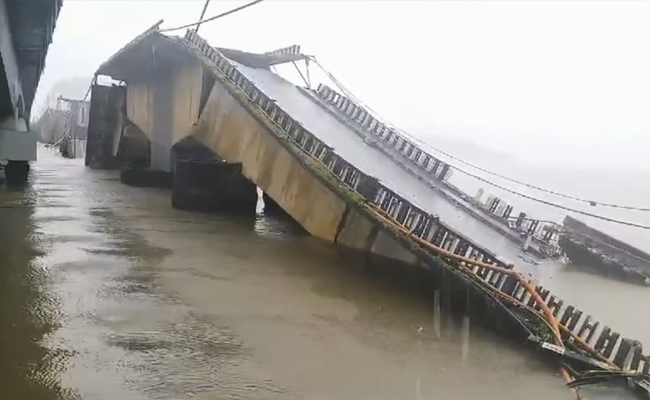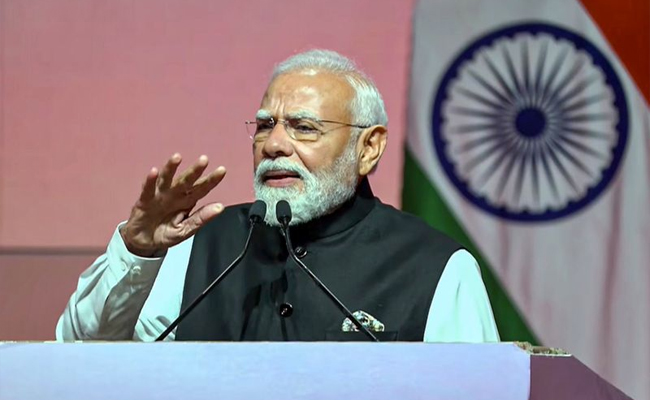Panaji (PTI): Authorities in neighbouring Karnataka on Wednesday ordered the National Highways Authority of India (NHAI) to check stability of the new Kali river bridge after an old bridge on the water body collapsed.
The old bridge on the river collapsed at around 1.30 am on Wednesday, resulted in heavy traffic on national highway no. 66 connecting Goa to Karnataka, officials said.
A truck crossing the bridge at the time fell into the river. Local fishermen later rescued its driver, a police official from Karwar in Uttar Kannada district of Karnataka told PTI.
The old bridge which collapsed was used for Goa-bound traffic after the construction of a new one a decade back, the official said.
Uttar Kannada District Magistrate Lakshmi Priya K said it has been brought to the notice that the old Kali river bridge connecting Karwar and Sadashivgad collapsed at 1.30 am on Wednesday.
ALSO READ: Traffic on Goa-Karnataka highway hit as Kali river bridge collapses
She ordered the NHAI officials concerned to verify and report stability of the new Kali river bridge connecting Karwar and Sadashivgad.
A stability report must be submitted by 12 noon on Wednesday, she said.
Traffic on the new bridge was stopped for some time in the wee hours of Wednesday following the incident. Later, vehicles, except heavy ones, were allowed to pass through, the Karwar police said.
Traffic movement on the new bridge was restricted as the Karnataka authorities were checking its stability after the collapse of the old bridge, Goa's Canacona police station in-charge Harish Raut Desai said.
The Goa police were coordinating with their counterparts in Karwar to monitor the situation on the highway, he said.
Let the Truth be known. If you read VB and like VB, please be a VB Supporter and Help us deliver the Truth to one and all.
New Delhi (PTI): Prime Minister Narendra Modi on Thursday said the world's trust in India is its biggest strength and emphasised the need to ensure that Indian Artificial Intelligence (AI) models are ethical, unbiased, transparent, and based on data privacy principles.
He also said that the startups should work towards global leadership from this country, and noted that India can promote affordable AI, inclusive AI, and frugal innovation globally.
Chairing a roundtable with Indian AI start-ups ahead of the India AI Impact Summit 2026, Modi suggested that Indian AI models should be distinct and should promote local and indigenous content and regional languages, an official statement said.
The prime minister said startups and artificial intelligence entrepreneurs are the co-architects of the country's future.
As many as 12 Indian AI start-ups that have qualified for the 'AI for ALL: Global Impact Challenge' summit to be held next month attended the roundtable and presented their ideas and work.
During the meeting, Modi highlighted the importance of artificial intelligence in bringing about transformation in society.
He noted that India will host the India AI Impact summit next month, through which the country will play a major role in the technology sector.
The prime minister highlighted that India is making efforts to bring about a transformation by leveraging AI.
He emphasised that startups and AI entrepreneurs are the co-architects of India's future and said the country has immense capacity for both innovation and large-scale implementation.
India should present a unique AI model to the world that reflects the spirit of 'Made in India, Made for the World', Modi said.
These start-ups are working in a diverse set of areas, including Indian language foundation models, multilingual LLMs, speech-to-text, text-to-audio and text-to-video; 3D content using generative AI for e-commerce, marketing, and personalised content creation; engineering simulations, material research and advanced analytics for data-driven decision-making across industries; healthcare diagnostics and medical research, among others.
The AI start-ups commended India's strong commitment to advancing the artificial intelligence ecosystem in the country. They highlighted the rapid growth and vast future potential of the AI sector, observing that the centre of gravity of artificial intelligence innovation and deployment is beginning to shift towards India.
The leaders said India now offers a robust and enabling environment for AI development, firmly placing the country on the global AI map.
The meeting was attended by CEOs, heads and representatives of Indian AI start-ups, including Avataar, BharatGen, Fractal, Gan, Genloop, Gnani, Intellihealth, Sarvam, Shodh AI, Soket AI, Tech Mahindra and Zenteiq.
Union Minister for Electronics and Information Technology Ashwini Vaishnaw and Minister of State Jitin Prasada were also present in the meeting.
A PMO press release reads, "PM chairs Roundtable with Indian AI Start-Ups. 12 Indian AI Start-ups, who have qualified for the AI for ALL: Global Impact Challenge in the India AI Impact Summit 2026, present their ideas and work." pic.twitter.com/RvjNly04hl
— Press Trust of India (@PTI_News) January 8, 2026




_vb_74.jpeg)
